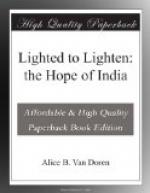The lawyer-father was the abiding influence in the daughter’s growth of mind and soul. A liberal Hindu he would have been called. In reality, he was one of that unreckoned number, the Nicodemuses of India, who come to Jesus by night, who render Him unspoken homage, but never open confession. A man of broad religious interests, he read the Hindu Gita, the Koran, and the Gospels; and among them all the words of Jesus held pre-eminence in his love and in his life. When in later years he found his daughter puzzling over Bible commentaries to clear up some question of faith, he asked impatiently, “Why do you bother with those books? Read the words of Jesus in the Gospels and act accordingly. That is enough.” Father and daughter were wonderful comrades. In all the years of separation when, as student and doctor, Paru was held on the opposite side of India, long weekly letters went back and forth, and events and thoughts were shared. When the hour of decision came, and the girl ventured into untried paths where the father could not follow, there were separation and misunderstanding for a time, but that time was short. The home visits were soon resumed and the Christian daughter was once more free to share home and meals with her Hindu family. And when one day the father said, “If a person feels a certain thing to be his duty, he should do it, whatever the cost,” Paru rejoiced, for she knew that her forgiveness was sealed.
Dr. Paru’s entrance into the world of medicine was due to her father’s wish rather than her own. He was of that rare type of social reformer who acts more than he speaks. Believing that eventually his daughter would marry, he felt that as a doctor from her own home she could carry relief and healing into her small neighborhood. Paru, to please her father, went into the long grind of medical college, conquered her aversion for the dissecting table, and “made good.” What does he think, one wonders, as, looking upon her to-day with the clearer vision of the life beyond, he sees the beloved daughter, thoughts of home and husband and children put aside, but with her name a household word among the women of a thousand homes. Ask her what she thinks of medicine as a woman’s profession and her answer will leave no doubt whether she believes it worth while.
Actual decision for Christ was a thing of slow growth, its roots far back in memories of bright-covered Gospels and convent prayers, fruit of open confession maturing only during her years of service at Guntur. Life in the Madras Y.W.C.A. had much to do with it. There were Indian Christian girls, fellow students. “No,” said Dr. Paru, “they didn’t talk much about it; they had Christian ideals and tried to live them.” There was a secretary, too, who entered into her life as a friend. “Paru,” she said at last, “you are neither one thing nor the other. If you aren’t going to be a Christian, go back and be a Hindu. At least, be something.” At Guntur there were the experiences of Christian service and fellowship. Finally, there were words spoken at a Christian meeting, “words that seemed meant for me”; and then the great step was taken, and Dr. Paru entered into the liberty that has made her free to appear outwardly what she long had been at heart.




